Hole in the Clouds
Nov 18, 2009

This mid-1950s photo, according to the little boy with glasses in the middle of it, records the moment he chose his life's work. His older brother, at left, is showing a photo album to a family friend. His older sister shot the picture.
What is the little boy thinking? He claims that the idea going through his mind is: "All I have to do is take some pictures, and everybody will pay attention to me."
I don't know who he is; he submitted the photo and many others to Shorpy, under the username tterrace.
vintage
1950s
(Image credit: tterrace, via Shorpy)
Sep 11, 2011
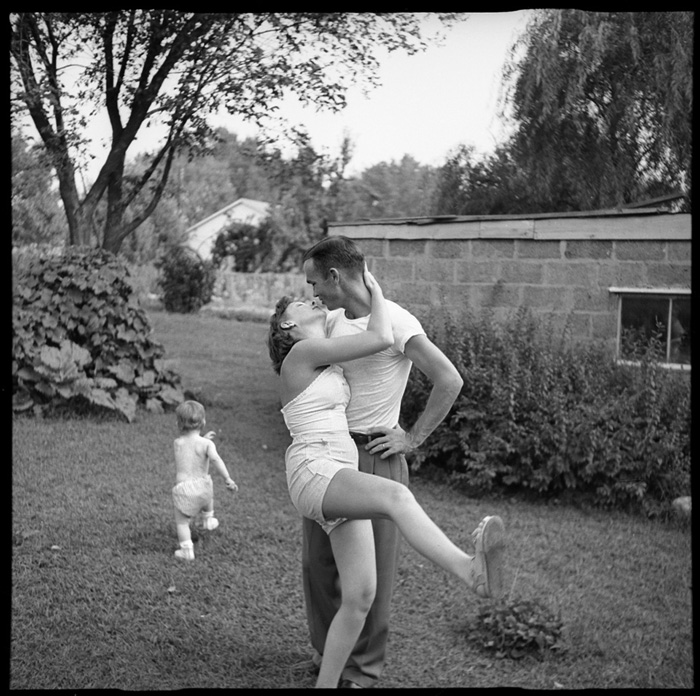 "Some time in the 1950s, probably in Decatur, Illinois." That's the baby boomer, stomping away.
"Some time in the 1950s, probably in Decatur, Illinois." That's the baby boomer, stomping away.
Illinois
baby
1950s
(h/t Shorpy)
Decatur
yardscape
kiss
couple
Nov 9, 2011
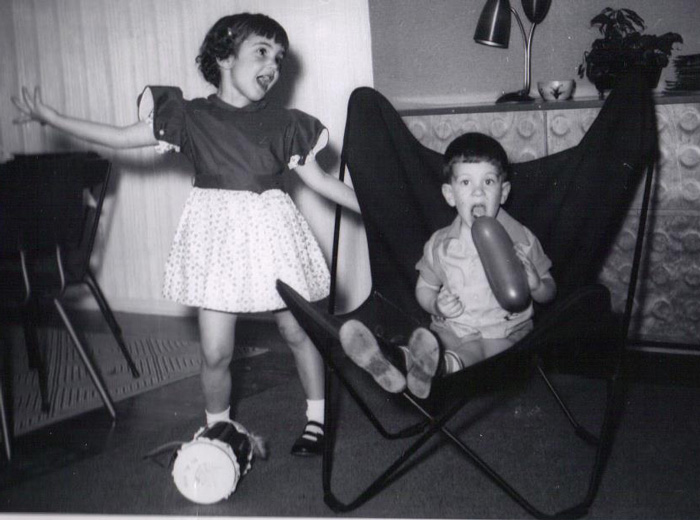 Somehow, Norman believes he can remember sitting in that chair and putting that balloon to his mouth, while Iris Quigley posed for the camera. The photo was probably taken in 1954, maybe 1955, in Iris's house, which was down the street from Norman's house in East Meadow, Long Island, New York. Great furniture, great dance moves, and we can hope those little baby teeth weren't too sharp.
Somehow, Norman believes he can remember sitting in that chair and putting that balloon to his mouth, while Iris Quigley posed for the camera. The photo was probably taken in 1954, maybe 1955, in Iris's house, which was down the street from Norman's house in East Meadow, Long Island, New York. Great furniture, great dance moves, and we can hope those little baby teeth weren't too sharp.
New York
vintage
Long Island
children
1950s
Norman
Iris
East Meadow
(h/t: Iris Quigley)
Mar 28, 2012
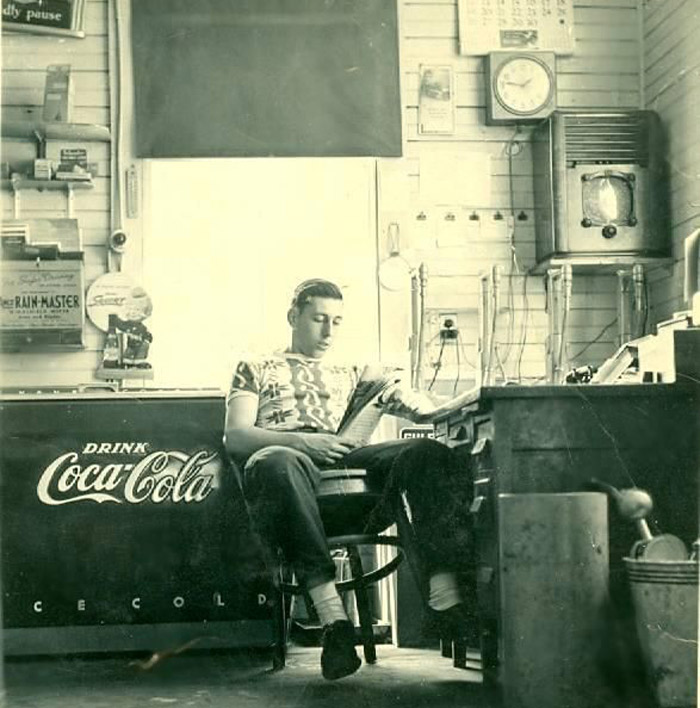 William Pinkerton, back in the day, hard at work at the dispatch desk at Bud Wood's taxi service in Rockland, Maine.
William Pinkerton, back in the day, hard at work at the dispatch desk at Bud Wood's taxi service in Rockland, Maine.
vintage
Maine
1950s
work
(h/t: Shorpy)
Rockland
Jun 22, 2012
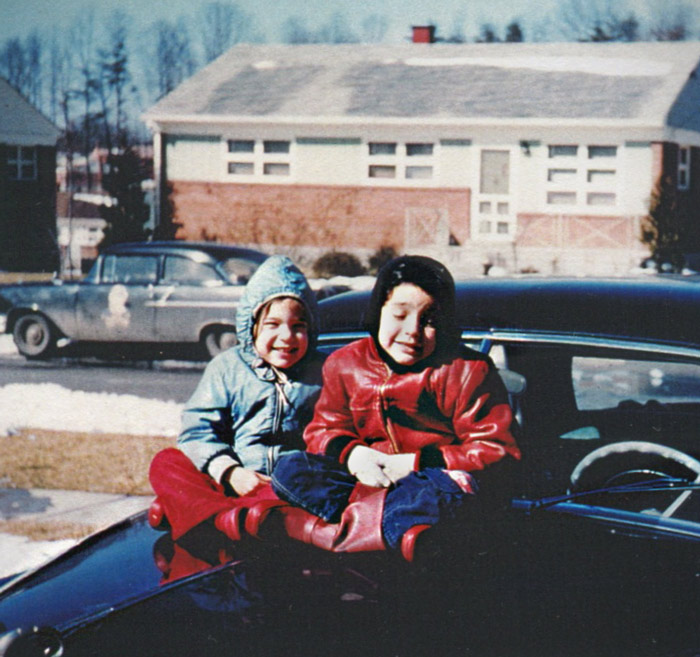 In the winter of 1957, my little sister Carol and I posed for a picture on the hood of my grandfather's Chevy, in the driveway next to our house in Silver Spring, Maryland. The house in the background across the street was identical to ours and to all the others in the neighborhood.
In the winter of 1957, my little sister Carol and I posed for a picture on the hood of my grandfather's Chevy, in the driveway next to our house in Silver Spring, Maryland. The house in the background across the street was identical to ours and to all the others in the neighborhood.
Neighborhoods like ours were called GI tracts back then, new subdivisions built for the baby-booming families of World War II veterans, who bought the houses with no down payment and bargain-rate VA mortgages. Every house was soon overflowing with kids; seven children grew up in that house across the street, and the houses on either side of ours both held six children. We never ran out of kids to play with.
A brand new school was built for us; it opened the year before I started kindergarten and was overcrowded from day one. But it was only a few short years, maybe fifteen or twenty, before the demographic bulge had moved on and MacDonald Knolls Elementary School actually closed down for lack of kids. The school building is now privately owned, used for office space with a small daycare center in one former classroom.
The neighborhood in general has morphed from GI tract to what I guess would be designated an ethnic community; most of the families living there now are Vietnamese, as are the businesses in nearby shopping centers.
I took the picture below of our old house about five years ago. It's a leafy, tree-shaded kind of place now, which was definitely not the case back in the day, though neighbors had put out small trees, supported by guy wires that we used to trip over. The house itself looks well-kept and largely unchanged, except for new windows and siding and a fancy new storm door.
Perhaps the most significant change is in the driveway: there are two cars there now, which is perfectly normal in 21st-century America, but back in the 1950s each family had only a single car. On Monday mornings, after the fathers drove off to work, the neighborhood was pretty much empty of cars and we kids had the streets to ourselves.
The second car is necessary because middle-class life now requires a second wage-earner. I read recently that since the Great Recession more and more households are needing a third wage-earner to make ends meet; new household formation in this country is almost at a standstill.
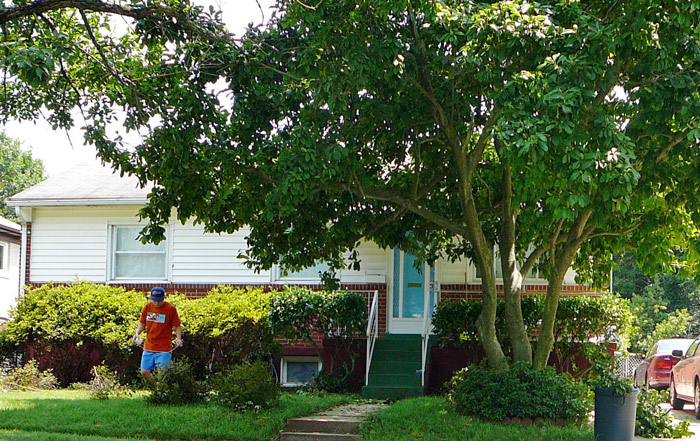
kids
cars
Maryland
streetscape
1950s
winter
Ellen
Carol
houses
Benson Terrace
Silver Spring
boots
Jul 4, 2012
 At the Fourth of July festivities in 1957 or thereabouts, probably out in back of Takoma Park Junior High School, my friend Edie and I hold hands with long tall Uncle Sam, while my sister Carol waves our balloons on high. Uncle Sam's hat, which may be an Indian headdress, appears to say "Bozell" on it. I have no idea why.
At the Fourth of July festivities in 1957 or thereabouts, probably out in back of Takoma Park Junior High School, my friend Edie and I hold hands with long tall Uncle Sam, while my sister Carol waves our balloons on high. Uncle Sam's hat, which may be an Indian headdress, appears to say "Bozell" on it. I have no idea why.
kids
children
1950s
Ellen
Carol
Fourth of July
Edie
stilts
fair
Uncle Sam
Oct 4, 2012
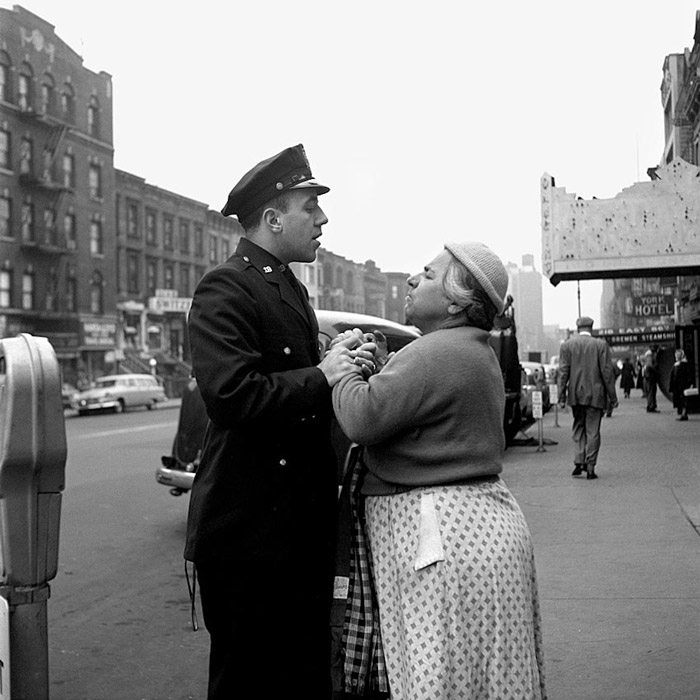 It's now been about two years since Vivian Maier's photographic oeuvre was discovered among the contents of a storage locker that was auctioned off in Chicago. Hundreds of the pictures have now been published in a book and shown in galleries in New York and Chicago. Dozens are posted on a website, VivianMaier.com. She is the subject of a documentary film project. Hundreds of rolls of film she shot have yet to be developed, and perhaps a hundred thousand of her negatives have yet to be printed.
It's now been about two years since Vivian Maier's photographic oeuvre was discovered among the contents of a storage locker that was auctioned off in Chicago. Hundreds of the pictures have now been published in a book and shown in galleries in New York and Chicago. Dozens are posted on a website, VivianMaier.com. She is the subject of a documentary film project. Hundreds of rolls of film she shot have yet to be developed, and perhaps a hundred thousand of her negatives have yet to be printed.
For fifty years, Maier worked as a nanny, first in New York and then in Chicago. Whenever she got a day off, she took her camera out on the street and shot pictures of the people she encountered. She spent all her earnings on cameras and film, and occasionally on travel to places she wanted to photograph. She became technically skillful, with a sophisticated eye for composition and drama. But she never showed her photographs to anyone.
In her later years, she fell on very hard times and became homeless. Shortly before her death in 2011, she was rescued by three Chicagoans who'd grown up under her care; by then, however, her financial struggles had forced her to sell off one of four storage lockers containing her life's work. The purchaser of the locker was a real estate developer named John Maloof, who'd thought he was buying old snapshots of his neighborhood. When he began to realize what he'd stumbled across, he set aside his regular work and devoted all his time to trying to track down the photographer.
Maier, born in 1926, was still alive in 2010 when Maloof began his search but had died before he could find her. We can't know what she would have thought of the whole world now having a look at the pictures she kept secret for so long. But at least we can look.
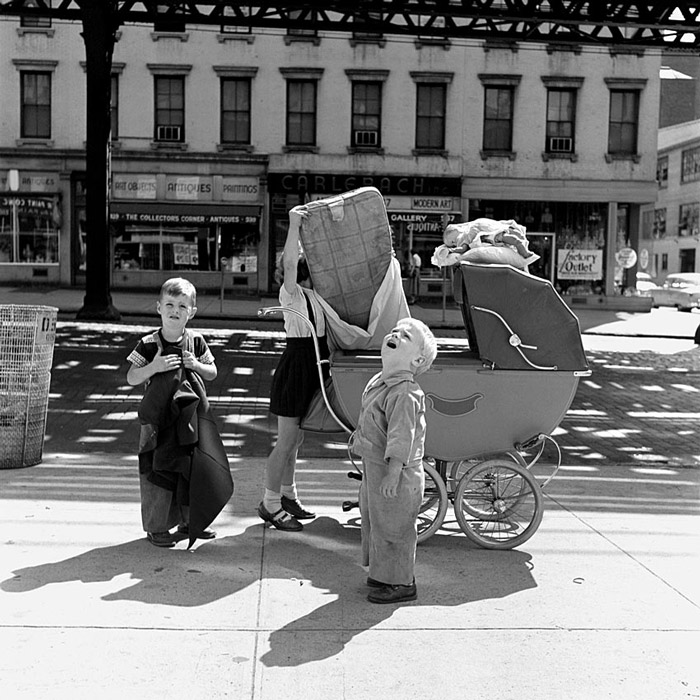

New York
Chicago
1950s
photography
portraits
streetscapes
(Image credits: Vivian Maier
Oct 30, 2012
 Philadelphia rode out the storm without much incident; lots of rain and small tree branches fell, and then that was that. We were the lucky ones this time.
Philadelphia rode out the storm without much incident; lots of rain and small tree branches fell, and then that was that. We were the lucky ones this time.
Although I haven't checked up on it with my own eyes, I'd lay money that this mural on East Passyunk is still standing. The performers celebrated on this wall–in autographed portraits designed by mural artist Peter Pagast to resemble the framed celebrity photos on a restaurant wall–were all born and raised in South Philadelphia: Frankie Avalon, Chubby Checker, Fabian, Bobby Rydell, Al Martino, Eddie Fisher, and in the upper right corner someone not so well known among us ignorant non-Philadelphia natives: disc jockey Jerry Blavat.
In 2005, when the mural was dedicated, all of them except Eddie Fisher showed up for a celebratory sock hop.
music
1950s
mural
South Philly
Italian Market
1960s
Frankie Avalon
Passyunk
Fabian
Bobby Rydell
Jerry Blavat
Al Martino
Chubby Checker
Eddie Fisher
(Image credit: Alex Yu) (Mural Art: Peter Pagast)



 William Pinkerton, back in the day, hard at work at the dispatch desk at Bud Wood's taxi service in Rockland, Maine.
William Pinkerton, back in the day, hard at work at the dispatch desk at Bud Wood's taxi service in Rockland, Maine. In the winter of 1957, my little sister Carol and I posed for a picture on the hood of my grandfather's Chevy, in the driveway next to our house in Silver Spring, Maryland. The house in the background across the street was identical to ours and to all the others in the neighborhood.
In the winter of 1957, my little sister Carol and I posed for a picture on the hood of my grandfather's Chevy, in the driveway next to our house in Silver Spring, Maryland. The house in the background across the street was identical to ours and to all the others in the neighborhood.
 At the Fourth of July festivities in 1957 or thereabouts, probably out in back of Takoma Park Junior High School, my friend Edie and I hold hands with long tall Uncle Sam, while my sister Carol waves our balloons on high. Uncle Sam's hat, which may be an Indian headdress, appears to say "Bozell" on it. I have no idea why.
At the Fourth of July festivities in 1957 or thereabouts, probably out in back of Takoma Park Junior High School, my friend Edie and I hold hands with long tall Uncle Sam, while my sister Carol waves our balloons on high. Uncle Sam's hat, which may be an Indian headdress, appears to say "Bozell" on it. I have no idea why.



